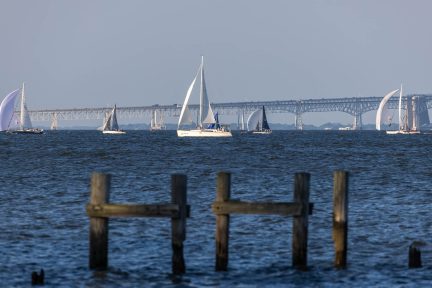Trends Show Jurisdictions Reducing Pollution Entering Chesapeake Bay
Trends Show Jurisdictions Reducing Pollution Entering Chesapeake Bay
Pollution controls put in place over the last five years have reduced the amount of nutrients and sediment entering the nation’s largest estuary. While pollution reducing trends continue to be positive, updated data show agricultural sources have sent more nitrogen and sediment into the Bay since 2007 than previously thought.
Each year, Delaware, Maryland, New York, Pennsylvania, Virginia, West Virginia and the District of Columbia report the steps they have taken to reduce the nutrients and sediment entering rivers and streams. Bay Program experts run this information through a suite of computer simulations, which generate pollution load estimates that show us how far our partners have come toward meeting the Bay’s “pollution diet.” When bolstered with new data on population size, land use and agricultural commodities, these simulations show a drop in pollution since 2009—the year before the U.S. Environmental Protection Agency (EPA) established the Chesapeake Bay Total Maximum Daily Load (Bay TMDL)—but a two percent rise in nitrogen and sediment loads between 2013 and 2014.
This slight increase in nitrogen and sediment loads is due in part to a short-term shift in agricultural commodities. According to data from the U.S. Department of Agriculture’s Census of Agriculture, which is published every five years, several watershed states have seen a rise in plantings of corn since 2007. Because corn requires nitrogen-rich fertilizer that can leach off the ground and into local waterways, more corn plantings led to more nitrogen loadings than the Bay Program anticipated when jurisdictions set their 2015 pollution targets and reduction milestones.
By incorporating the most recent and verifiable data into our computer simulations and pollution load estimates, we can more accurately track our partners’ progression toward their pollution-reducing goals. A more accurate picture of pollution in the watershed gives us a better understanding of the actions that are needed to restore water quality.
These pollution load estimates, which are derived from land use and best management practice implementation, are just one in a suite of tools the EPA uses to evaluate whether jurisdictions are on track to meet the Bay TMDL and its two-year milestone commitments. The EPA also considers data and information on best management practice implementation, best management practice effectiveness and jurisdictions’ progress toward putting programs in place to achieve pollution cuts. It is expected to release interim assessments of jurisdictions’ work in May and conduct the next full two-year assessment in 2016.
When the Bay TMDL was developed, Bay Program partners agreed that a comprehensive reassessment would be performed in 2017 to integrate the latest science and data on nutrient and sediment sources and their transport to the Bay. The Bay TMDL Midpoint Assessment will take into account the latest science on nutrient and sediment sources and their transport to the Bay, including research on phosphorus transport and saturation in soils; monitoring trends that show increasing phosphorus loads in six of the nine river basins that drain to the Bay; and a March 2015 U.S. Geological Survey (USGS) report that links excess fertilizer and livestock manure to worsening phosphorus trends on the Eastern Shore. Based on this information, the EPA believes the level of effort it will take to manage phosphorus across the region could increase.
Facts
Chesapeake Bay Program simulations show that our partners’ efforts to control pollution over the last five years have reduced nitrogen loads to the Chesapeake Bay by 6 percent, phosphorus loads by 18 percent and sediment loads by 4 percent.
Between 2009 and 2014:
- Nitrogen loads fell 15.83 million pounds to 266.83 million pounds per year.
- Phosphorus loads fell 3.40 million pounds to 15.82 million pounds per year.
- Sediment loads fell 327 million pounds to 8.35 billion pounds per year.
This represents 21 percent of the nitrogen reductions, 71 percent of the phosphorus reductions and 25 percent of the sediment reductions needed to meet our goal of having all of the pollution-reducing practices in place by 2025 that would achieve water quality standards as compared to 2009, the year before the U.S. Environmental Protection Agency (EPA) established the Chesapeake Bay Total Maximum Daily Load (Bay TMDL). The Chesapeake Bay Watershed Agreement Watershed Implementation Plans Outcome is to have those practices in place by 2017 that would achieve 60 percent of the nutrient and sediment load reductions necessary to achieve water quality standards compared to 2009.
The computer simulations that generate the Reducing Nitrogen, Phosphorus and Sediment indicators do so using long-term average weather conditions. It is possible for these modeling estimates of pollution loads to differ from those based on water quality monitoring data, which can vary with the amount of rainfall in a single year.
Issues
Excess nutrients and sediment impair water quality. Nitrogen and phosphorus can fuel the growth of algae blooms that lead to low-oxygen “dead zones” that suffocate marine life. Sediment can block sunlight from reaching underwater grasses and suffocate shellfish. Best management practices used in backyards, in cities and on farms can lower the flow of nutrients and sediment into waterways.
Importance
The Chesapeake Bay Program’s Reducing Pollution indicators present data on our partners’ progress toward reducing the nitrogen, phosphorus and sediment entering rivers, streams and the Chesapeake Bay. This data provides local leaders with the science-based information they need to assess their pollution-reducing practices and adapt their management decisions as needed.
Jurisdictions’ progress toward reducing nutrient and sediment pollution is a product of their work to meet the Chesapeake Bay Total Maximum Daily Load (Bay TMDL) or “pollution diet.” Jurisdictions’ Watershed Implementation Plans (WIPs) outline the strategies each will take to meet the Bay TMDL; these strategies are being implemented through a series of two-year milestones. The U.S. Environmental Protection Agency (EPA) oversees progress toward these goals.
Quotes
“Each year, we employ the most current data and up-to-date science so that we can offer the highest quality information to the public on pollution reductions resulting from Chesapeake Bay Program partners’ continued efforts. While we clearly have a lot of work to do, collectively we are making steady progress toward meeting water quality goals. We continually improve upon our management practices and reporting systems, but the Bay ecosystem restoration effort remains a constant challenge. The Chesapeake Bay Watershed Agreement and the associated water quality strategies give us clear plans for how to focus our work and redouble our efforts to restore balance in the ecosystem and rebuild its resilience.”
--- Nick DiPasquale, Director, Chesapeake Bay Program
“Chesapeake Bay Program partners’ commitments and continued efforts to reduce nitrogen, phosphorus and sediment pollution continue to be laudable. These estimates of the effects of our pollution reducing efforts provide each partner with the most scientifically sound, vital information upon which to base our collective decisions as a partnership. As always, whether in urban or rural environments, we must all continue to do our part for the health of our waters and our environment.”
--- Molly Ward, Virginia Secretary of Natural Resources and Chair, Chesapeake Bay Program Principals’ Staff Committee



